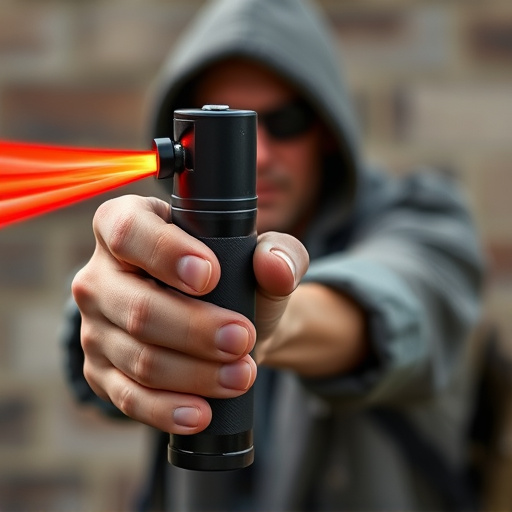Pepper spray, an oleoresin capsaicin (OC) self-defense tool, offers various heat levels tailored to specific needs. Lower heat levels are milder, suitable for de-escalation or close-quarters escape, while higher levels provide stronger but shorter protection for outdoor attacks. Effective use requires understanding these differences, adhering to legal restrictions, and proper handling. Heat level considerations, legal verification, safe storage, and responsible deployment techniques ensure optimal OC spray performance as a last resort defense option.
“Staying safe is a top priority, especially when considering self-defense options. Pepper spray, also known as Oleoresin Capsaicin (OC) spray, is a powerful tool for personal protection. This article guides you through the essentials of pepper spray as a self-defense weapon. From understanding its active ingredient and heat levels—including the significant differences between various OC sprays—to safe handling practices and legal considerations, we explore what you need to know. Learn how to make informed decisions and use this tool responsibly.”
- Understanding Pepper Spray: A Self-Defense Weapon Overview
- Heat Level Differences in OC Sprays: What You Need to Know
- Safe Handling and Storage Practices for Optimal Effectiveness
- Legal Considerations and Responsible Use Guidelines
Understanding Pepper Spray: A Self-Defense Weapon Overview
Pepper spray, also known as oleoresin capsaicin (OC) spray, is a non-lethal self-defense weapon designed to temporarily incapacitate an attacker by causing pain and irritation. Understanding its mechanics and safety considerations is crucial for effective deployment. OC sprays come in various heat levels, with differences in potency ranging from mild to extremely powerful. These variations significantly impact the distance at which the spray can be effectively used and the duration of its effects.
The “heat level” refers to the concentration of capsaicin, a chemical compound responsible for the burning sensation associated with chili peppers. Lower heat levels are suitable for close-quarters defense, offering a milder irritant effect that can enable an individual to escape or disable an attacker temporarily. Conversely, higher heat levels provide stronger but shorter-lasting protection, making them ideal for outdoor situations where attackers may be more resistant to the spray’s effects. Awareness of these differences is vital for users to choose and deploy the most effective pepper spray for their specific needs and environments.
Heat Level Differences in OC Sprays: What You Need to Know
The effectiveness of pepper spray self-defense weapons isn’t just determined by their potency; it’s also heavily influenced by heat level differences among various types of OC (oleoresin capsicum) sprays. These heat levels refer to the intensity of the capsaicin, the chemical responsible for the burning sensation associated with chili peppers. Lower heat levels result in milder irritants, while higher ones produce more intense effects.
Understanding these variations is crucial when selecting a self-defense spray. High heat level OC sprays can cause immediate disorientation and immobilization, making them ideal for close-quarters encounters. Conversely, lower heat options may provide sufficient deterrence without causing permanent harm or long-lasting discomfort, making them preferable for situations where de-escalation is a priority. Always consider your specific needs, surroundings, and legal restrictions when choosing an OC spray with the appropriate heat level.
Safe Handling and Storage Practices for Optimal Effectiveness
Proper handling and storage are paramount for ensuring pepper spray remains effective when needed. Always treat pepper spray with care, storing it in a cool, dry place away from direct sunlight or extreme heat. Understand that different OC (Oleoresin Capsicum) sprays have varying heat levels, so check the manufacturer’s instructions for recommended storage conditions. Some sprays may require refrigeration to maintain potency. Additionally, keep pepper spray out of reach of children and unauthorized individuals, using child-resistant packaging if available.
Avoid contaminating your pepper spray by keeping it sealed until use. Never store or carry pepper spray near food or in areas prone to moisture or humidity. Regularly inspect the nozzle for blockages or damage, and ensure the safety clip is securely attached. Before storing, test the spray mechanism to ensure proper function. Following these simple practices will contribute to maximizing the effectiveness of your self-defense tool when it matters most.
Legal Considerations and Responsible Use Guidelines
When considering pepper spray as a self-defense weapon, it’s crucial to understand the legal implications and responsible use guidelines. The legality of carrying pepper spray varies by jurisdiction, with some regions allowing it only for specific purposes or requiring permits. Additionally, different types of pepper spray have varying heat levels (OC sprays), which can impact their effectiveness and potential side effects. Always check local laws to ensure compliance, as using pepper spray illegally can result in severe penalties.
Responsible use involves understanding the spray’s range, wind conditions, and targets. Users should aim for eyes and face, as these areas are most vulnerable. Pepper spray is non-lethal but can cause temporary blindness, breathing difficulties, and extreme pain, so it should be a last resort. Training and familiarization with the device are essential to ensure accurate deployment in high-stress situations.
Pepper spray, a powerful self-defense tool, offers effective protection when used responsibly. Understanding the heat levels of different OC sprays is key, as it ensures you’re prepared for various situations. Safe handling and storage practices are paramount to maintain its effectiveness. Additionally, being aware of legal considerations and adhering to responsible use guidelines is essential to protect yourself and others. By combining these practices with knowledge of OC spray properties, individuals can maximize their self-defense capabilities while minimizing risks.
